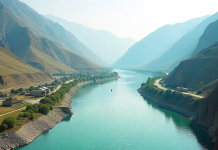Sadaf Noreen Awan
The Kashmir dispute has remained a bone of contention between two nuclear powers of South Asia – India and Pakistan – both of whom have fought three major wars over the region, seeking territorial supremacy for decades. Despite several resolutions and interventions by the United Nations, the issue remains unresolved, keeping over 1.6 billion people—about one-fifth of the world’s population—under the looming threat of war, especially under the nationalist regime of Indian Prime Minister Narendra Modi.
Recent tensions escalated due to a false Indian allegation against Pakistan following the Pahalgam attack in Indian-occupied Kashmir on April 22, 2025, where 26 people, including Muslims, were reportedly killed. Despite deploying 900,000 troops in the region, the Indian government failed to provide adequate security. Within ten minutes of the incident, India filed an FIR against Pakistan without any evidence or investigation. Pakistan’s political and military leadership condemned the attack and offered full cooperation for a transparent investigation.
Narendra Modi, seeking political mileage ahead of elections, suspended the Indus Waters Treaty of 1960 and made inflammatory speeches against Pakistan. Indian media amplified war hysteria, while Pakistan’s Army Chief General Syed Hafiz Asim Munir warned that any Indian misadventure would be met with a decisive response.
India violated international border laws by launching missile strikes on six Pakistani locations, including mosques and civilian areas, on the night of May 6–7, 2025. These attacks were termed “Operation Sindoor.” Pakistan defended its territory and condemned the violations. National and international media reported the facts, despite Indian media’s attempts to conceal the truth.
On May 9, India escalated the situation further by sending 88 Israeli-made drones into major Pakistani cities, all of which were neutralized by Pakistan’s defense systems. India then staged drone attacks on its own cities to falsely implicate Pakistan. Pakistan’s DG ISPR General Ahmed Sharif Chaudhary rejected the claims, stating, “When we respond, the world will hear it.”
Later that night, India attacked Pakistani military airbases in Rawalpindi, Shorkot, and Muridke. After three days of strategic patience, Pakistan launched Operation Bunyan ul Marsoos on May 10, targeting 26 Indian sites, including BrahMos missile storage in Beas and the Udhampur airbase. Pakistan’s cyber units also disabled Indian power and defense infrastructure.
Around 5 PM, former US President Donald Trump mediated a ceasefire. The war hysteria and Modi government’s conspiracy were exposed globally. With unity and public support, Pakistan’s leadership and armed forces successfully defended the nation. Prime Minister Shehbaz Sharif declared May 10 as “Youm-e-Marka-i-Haq” to be commemorated annually.
This conflict marked a shift in regional warfare dynamics. In the largest dogfight in South Asian history, 150 jets engaged. Pakistan’s JF-17 Thunders, built with Chinese support, downed six Indian jets including three Rafales, showcasing superior pilot skill and technology. CNN reported this as a major test for Chinese military equipment.
China, which supplies 81% of Pakistan’s arms, witnessed global validation of its military technology. Pakistan became the first nation to shoot down Rafale jets using Chinese aircraft, leading to a decline in Rafale’s global reputation. The power balance in South Asia is shifting, with China rising in a multipolar world.
India must reconsider its strategic assumptions, as future confrontations may not be limited to Pakistan but could involve China. The question remains: Is India prepared for a two-front challenge over Kashmir?

















